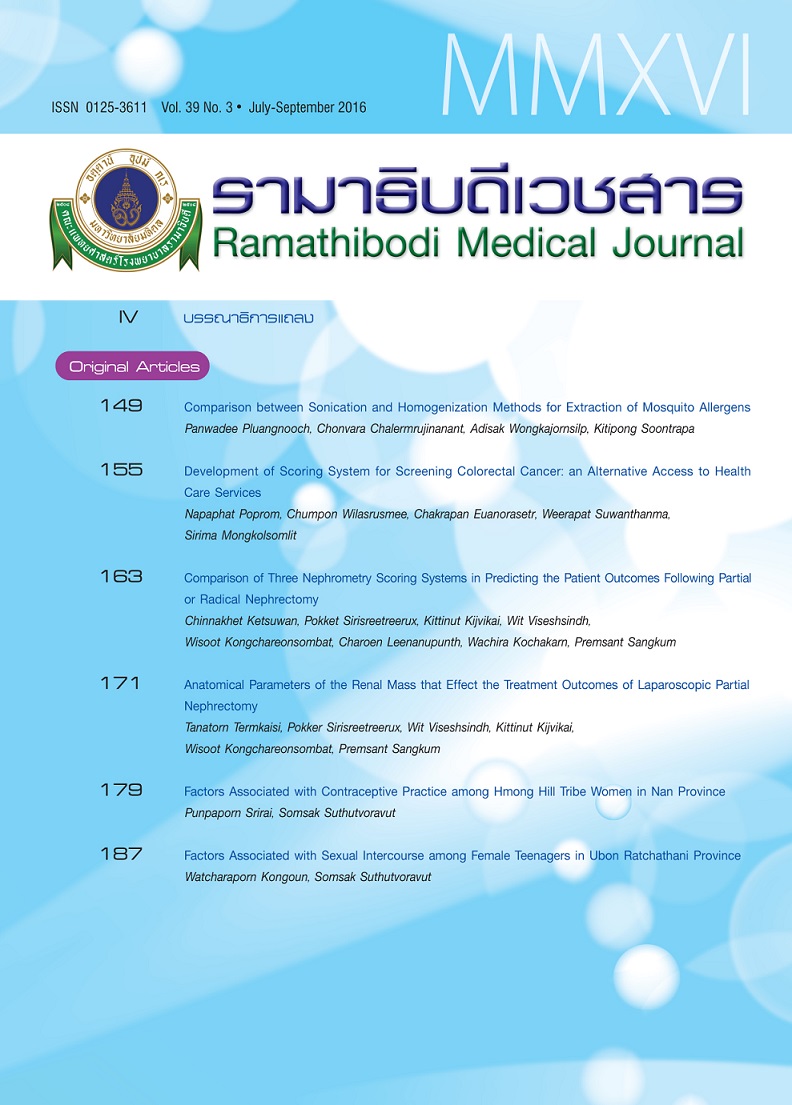Anatomical Parameters of the Renal Mass that Effect the Treatment Outcomes of Laparoscopic Partial Nephrectomy
Keywords:
Laparoscopic partial nephrectomy, Small renal mass, R.E.N.A.L. nephrometry scoreAbstract
Objectives: Partial nephrectomy is the newly treatment of choice for management of small renal mass. The warm ischemic time (WIT) is the most important factor that affects postoperative renal function. In this study, we explored the anatomical factors of the renal mass that influence warm ischemic time and perioperative outcomes during laparoscopic partial nephrectomy (LPN).
Materials and Methods: We performed a single institutional, retrospective analysis in the patients who underwent LPN at Ramathibodi Hospital from 2007 to 2013. The anatomy of the renal mass was evaluated preoperatively by computed tomography or magnetic resonance imaging according to R.E.N.A.L. nephrometry scoring system (radius, exophytic/endophytic, growth pattern, nearness of the collecting system, anterior/posterior and location). Statistical analysis was performed to evaluate the associations between the anatomy of renal mass and WIT, operative time (OT), estimated blood loss (EBL) and postoperative complications.
Results: A total of 28 patients underwent LPN from 2007 to 2013. The average tumor size was 3.75 cm (range 0.8-8.5 cm), 62.3% of these masses were < 4 cm in diameters, 21.4% were 4-7 cm and 16.3% were > 7 cm. For growth pattern of the renal mass: 25% were exophytic 50% and 75% were exophytic < 50%. The location of the tumors: 67.9% were in anterior part of the kidney, 24.9% were in posterior part and 14.3% were located between the anterior and posterior part of the kidney. In addition, 35.7% were upper pole tumors, 28.6% were in the lower pole, and 35.7% were in interpolar location. According to R.E.N.A.L. scoring system, the nearness of the collecting system was the only factor that was found to be significantly correlated with EBL (P = 0.036). From our results, anatomical factors of renal mass could not predict OT and WIT.
Conclusions: The nearness of collecting system of renal mass is a useful parameter for the prediction of EBL during LPN.
References
Chow WH, Devesa SS. Contemporary epidemiology of renal cell cancer. Cancer J. 2008;14:288-301.
Campbell SC, Novick AC, Belldegrun A, Blute ML, Chow GK, Derweesh IH, et al. Guideline for management of the clinical T1 renal mass. J Urol. 2009;182:1271-9.
MacLennan S, Imamura M, Lapitan MC, Omar MI, Lam TB, Hilvano-Cabungcal AM, et al. Systematic review of perioperative and quality-of-life outcomes following surgical management of localised renal cancer. Eur Urol. 2012;62:1097-117.
MacLennan S, Imamura M, Lapitan MC, Omar MI, Lam TB, Hilvano-Cabungcal AM, et al. Systematic review of oncological outcomes following surgical management of localised renal cancer. Eur Urol. 2012;61:972-93.
Kutikov A, Uzzo RG. The R.E.N.A.L. nephrometry score: a comprehensive standardized system for quantitating renal tumor size, location and depth. J Urol. 2009;182:844-53.
Naya Y, Kawauchi A, Oishi M, Ueda T, Fujihara A, Nakamura T, et al. Comparison of diameter-axial-polar nephrometry and RENAL nephrometry score for treatment decision making in patients with small renal mass. Int J Clin Oncol. 2015;20:358-61.
MacLennan S, Imamura M, Lapitan MC, Omar MI, Lam TB, Hilvano-Cabungcal AM, et al. Systematic review of oncological outcomes following surgical management of localised renal cancer. Eur Urol. 2012;61:972-93.
Van Poppel H, Becker F, Cadeddu JA, Gill IS, Janetschek G, Jewett MA, et al. Treatment of Localised Renal Cell Carcinoma. Eur Urol. 2011;60:662-72.
Hayn MH, Schwaab T, Underwood W, Kim HL. RENAL nephrometry score Predicts surgical outcomes of laparoscopic partial nephrectomy. BJU Int. 2011;108: 876-81.
Ellison JS, Montgomery JS, Hafez KS, Miller DC, He C, Wolf JS Jr, et al. Association of RENAL nephrometry score with outcomes of minimally invasive partial nephrectomy. Int J Urol. 2013;20:564-70.
Rosevear HM, Gellhaus PT, Lightfoot AJ, Kresowik TP, Joudi FN, Tracy CR. Utility of the RENAL nephrometry scoring system in the real world: predicting surgeon operative preference and complication risk. BJU Int. 2012;109:700-5.
Downloads
Published
How to Cite
Issue
Section
License
Copyright (c) 2016 By the authors. Licensee RMJ, Faculty of Medicine Ramathibodi Hospital, Mahidol University, Bangkok, Thailand

This work is licensed under a Creative Commons Attribution-NonCommercial-NoDerivatives 4.0 International License.













